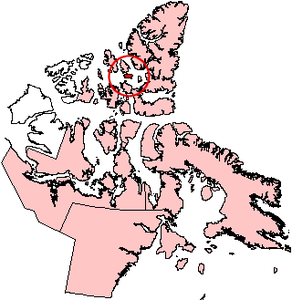Cornwall Island (Nunavut)
| Cornwall Island | |
|---|---|
| Cornwall Island satellite image | |
| Waters | Arctic Ocean |
| Archipelago | Queen Elizabeth Islands |
| Geographical location | 77 ° 37 ′ N , 94 ° 38 ′ W |
| length | 77 km |
| width | 38 km |
| surface | 2 358 km² |
| Highest elevation | Mount Nicolay 360 m |
| Residents | uninhabited |
| Map of the island | |
Cornwall Iceland is an island in the territory of Nunavut in Canada and one of the Queen Elizabeth Islands .
geography
Cornwall Island lies to the west of Norwegian Bay . Northwest of the island is, separated by the Hendriksen Strait , Amund Ringnes Island , south, on the other side of the Belcher Channel , Devon Island , in the northeast Axel Heiberg Island and in the east Graham Island and Buckingham Island .
Cornwall Island is 77 km long and 13 to 38 km wide. The island is 2358 km² and reaches a height of about 360 m in Mount Nicolay near the north coast . To the east of it is the 21 hectare and 31 m deep Nicolay Lake .
history
The island has played no special role in the history of polar exploration. It was discovered by Sir Edward Belcher on August 30, 1852 and named after Edward, Prince of Wales and Duke of Cornwall, later King Edward VII . Belcher landed at Pell Point on the south coast. During Otto Sverdrup's Second Norwegian Fram Expedition , Gunnar Isachsen and Sverre Hassel went dog sledding along the north coast in 1901 without entering the island. Next, the American Donald MacMillan (1874-1970) landed on the north coast at McLeod Head . In April 1932 a squadron of the Royal Canadian Mounted Police crossed the island in a vain search for the missing German polar explorer Hans Krüger .
Web links
- Cornwall Island ( Memento of May 10, 2011 in the Internet Archive ) in the island encyclopedia www.oceandots.com (English)
Individual evidence
- ↑ The Atlas of Canada - Queen Elizabeth Islands ( Memento from January 22, 2013 in the Internet Archive ) (English)
- ^ Scott F. Lamoureux, John H. England, Martin J. Sharp, Andrew BG Bush: A varve record of increased 'Little Ice Age' rainfall associated with volcanic activity, Arctic Archipelago, Canada (PDF; 1.7 MB). In: The Holocene 11 (2), 2001, pp. 243-249
- ^ William James Mills: Exploring Polar Frontiers - A Historical Encyclopedia , Vol. 1, ABC-CLIO, 2003, ISBN 1-57607-422-6 , p. 163 (English)


